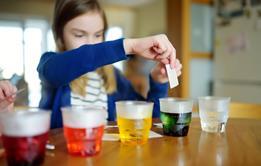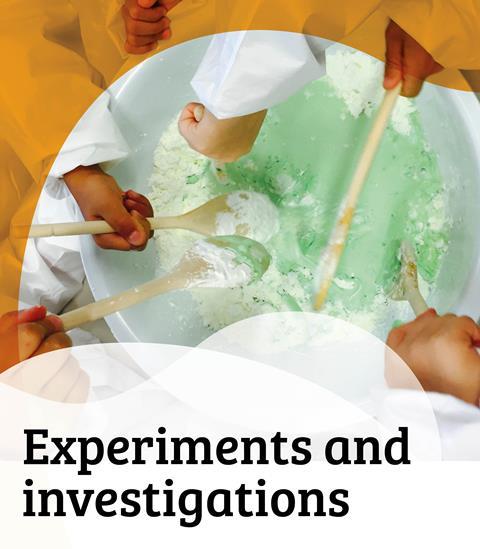A felt tip, kitchen roll, and a little water is all you’ll need to practice chromatography
Coloured inks are made up of several different colours that mix together to create that specific shade. These different colours will travel different distances in water, separating as they go. This means that learners can see each of the colours that go into their favourite ink pen.
Learning objectives
- Use knowledge of solids, liquids and gases to decide how mixtures might be separated.
- Compare and group together everyday materials on the basis of their properties, including their solubility.
In this video, education coordinator Ross demonstrates how to do ink chromatography with kitchen roll and felt tip pens. This simple activity can be set for learners to try at home with a responsible adult or used as a classroom experiment.
Equipment list
- Felt tip pens (non-washable)
- Kitchen roll
- A bowl or cup
- Water
- Scissors
Health and safety
- Make sure that you thoroughly clean any equipment after the experiment before using for food
Learning objectives
- Use knowledge of solids, liquids and gases to decide how mixtures might be separated.
- Compare and group together everyday materials on the basis of their properties, including their solubility.
Skill development
Learners will develop their working scientifically skills by:
- Using appropriate scientific language and ideas to explain, evaluate and communicate their methods and findings.
- Drawing conclusions and raising further questions that could be investigated, based on their data and observations.
- Asking their own questions about scientific phenomena.
Activity instructions
Method 1
- Take a sheet of kitchen roll and draw a simple picture with a non-washable felt tip pen.
- Place the sheet over an empty bowl. This is to keep the paper from getting too wet.
- Carefully add a few drops of water using your fingertips or a small paintbrush onto the drawing.
- Once slightly damp, watch the picture on the kitchen roll for a few minutes and see the different colours separate out.
Method 2
- Cut a long strip of kitchen roll. Draw a single coloured dot with a non-washable felt tip pen about 2–3 cm from the bottom of the strip.
- Add a small amount of water to the bottom of a bowl.
- Carefully place the dot-end of the strip into the water, without submerging the dot in the water (the water level should be lower than the dot on the strip) and let the rest of the strip hang over the edge of the bowl.
- Watch as the water absorbs up the paper strip and through the coloured dot. See what happens to the ink.
Explanation
Coloured inks are often made up of several different inks. Each colour of ink will get carried a different distance by the water, allowing you to see all of the different inks. Try this with different colours to see what actually goes into a colour. This technique is called chromatography and can be used in chemistry to find out what is in an unknown mixture.
Teaching tip
You may need to experiment with a range of black pens beforehand, as some pens work better than others.
Also check out
- More simple experiments using everyday equipment, which your learners can try at home or you can bring to the classroom on our YouTube playlist
- Read the CLEAPSS guidance on practical activities for pupils at home during extended periods of school closure, GL339.
- Read the SSERC guidance for primary home learning.
Downloads
Kitchen roll chromatography teacher notes
Editable handout | Word, Size 88.17 kbKitchen roll chromatography teacher notes
Handout | PDF, Size 31.94 kb
From kitchen to classroom

Simple chemistry experiments using kitchen cupboard equipment. Use in the classroom or set as an activity for learners to do at home with a responsible adult.
- 1
- 2
- 3
- 4
- 5
- 6
 Currently
reading
Currently
reading
Kitchen roll chromatography
- 8
- 9
- 10




























1 Reader's comment